 W
WThe Revolutions of 1848, known in some countries as the Springtime of the Peoples or the Spring of Nations, were a series of political upheavals throughout Europe in 1848. It remains the most widespread revolutionary wave throughout European history.
 W
WThe April Revolt, in the history of Portugal, was an absolutist political revolt that took place in April 1824. It succeeded the Vilafrancada (1823) and foreshadowed the Portuguese Civil War (1828–1834).
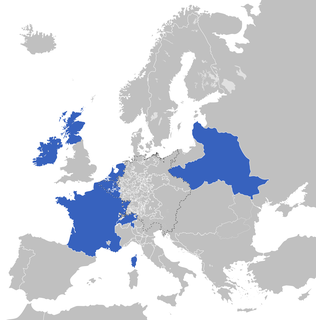 W
WThe Atlantic Revolutions were a revolutionary wave in the late eighteenth and early nineteenth centuries. It was associated with the Atlantic World during the era from the 1760s to the 1870s.
 W
WThe Belgian Revolution was the conflict which led to the secession of the southern provinces from the United Kingdom of the Netherlands and the establishment of an independent Kingdom of Belgium.
 W
WThe British Agricultural Revolution, or Second Agricultural Revolution, was the unprecedented increase in agricultural production in Britain due to increases in labour and land productivity between the mid-17th and late 19th centuries. Agricultural output grew faster than the population over the century to 1770, and thereafter productivity remained among the highest in the world. This increase in the food supply contributed to the rapid growth of population in England and Wales, from 5.5 million in 1700 to over 9 million by 1801, though domestic production gave way increasingly to food imports in the nineteenth century as the population more than tripled to over 35 million. The rise in productivity accelerated the decline of the agricultural share of the labour force, adding to the urban workforce on which industrialization depended: the Agricultural Revolution has therefore been cited as a cause of the Industrial Revolution.
 W
WThe Cantonal rebellion was a cantonalist insurrection that took place during the First Spanish Republic between July 1873 and January 1874. Its protagonists were the "intransigent" federal Republicans, who wanted to establish immediately the Federal Republic from the bottom-up without waiting for the Constituent Cortes to draft and approve the new Federal Constitution, as defended by the president of the Executive Power of the Republic Francisco Pi y Margall, a Proudhonian Mutualist supported by the "centrist" and "moderate" sectors of the Federal Democratic Republican Party.
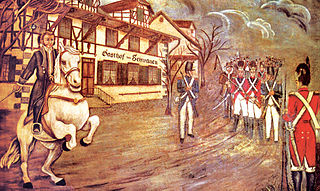 W
WThe Freiämtersturm in December 1830 was a bloodless revolution in the Swiss canton of Aargau. The dissatisfied rural population of the Freie Ämter region in Aargau marched on the cantonal capital of Aarau to demand changes in the cantonal constitution. The Freiämtersturm, together with other uprisings in 1830–31 led to the end of the Restoration period and the beginning of the liberal Regeneration period. The changes during the Regeneration led to the creation of the Federal State in 1848.
 W
WThe German revolutions of 1848–49, the opening phase of which was also called the March Revolution, were initially part of the Revolutions of 1848 that broke out in many European countries. They were a series of loosely coordinated protests and rebellions in the states of the German Confederation, including the Austrian Empire. The revolutions, which stressed pan-Germanism, demonstrated popular discontent with the traditional, largely autocratic political structure of the thirty-nine independent states of the Confederation that inherited the German territory of the former Holy Roman Empire after its dismantlement as a result of the Napoleonic Wars. This process began in the mid 1840s.
 W
WThe Glorious Revolution took place in Spain in 1868, resulting in the deposition of Queen Isabella II. The success of the revolution marked the beginning of the Sexenio Democrático with the installment of a provisional government.
 W
WThe Greek War of Independence, also known as the Greek Revolution, was a successful war of independence waged by Greek revolutionaries against the Ottoman Empire between 1821 and 1830. The Greeks were later assisted by Great Britain, France and Russia, while the Ottomans were aided by their North African vassals, particularly the eyalet of Egypt. The war led to the formation of modern Greece. The revolution is celebrated by Greeks around the world as independence day on 25 March.
 W
WThe Hawaiian rebellions and revolutions took place in Hawaii between 1887 and 1895. Until annexation in 1898, Hawaii was an independent sovereign state, recognized by the United States, United Kingdom, France and Germany with exchange of ambassadors. However, there were several challenges to the reigning governments of the Kingdom and Republic of Hawaii during the 8 1⁄2-year (1887–1895) period.
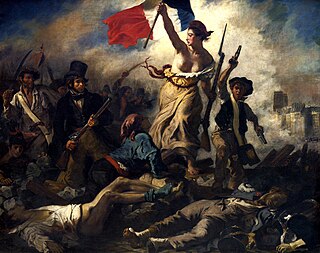 W
WThe French Revolution of 1830, also known as the July Revolution, Second French Revolution or Trois Glorieuses in French, led to the overthrow of King Charles X, the French Bourbon monarch, and the ascent of his cousin Louis Philippe, Duke of Orléans, who himself, after 18 precarious years on the throne, would be overthrown in 1848. It marked the shift from one constitutional monarchy, under the restored House of Bourbon, to another, the July Monarchy; the transition of power from the House of Bourbon to its cadet branch, the House of Orléans; and the replacement of the principle of hereditary right by that of popular sovereignty. Supporters of the Bourbon would be called Legitimists, and supporters of Louis Philippe Orléanists.
 W
WThe city of La Paz experienced a revolution in 1809 that deposed Spanish authorities and declared independence. It is considered one of the early steps of the Spanish American wars of independence, and an antecedent of the independence of Bolivia. However, such revolution was defeated shortly afterwards, and the city returned to Spanish rule.
 W
WThe Liberal Revolution of 1820 was a Portuguese political revolution that erupted in 1820. It began with a military insurrection in the city of Porto, in northern Portugal, that quickly and peacefully spread to the rest of the country. The Revolution resulted in the return in 1821 of the Portuguese Court to Portugal from Brazil, where it had fled during the Peninsular War, and initiated a constitutional period in which the 1822 Constitution was ratified and implemented. The movement's liberal ideas had an important influence on Portuguese society and political organization in the nineteenth century.
 W
WThe 1878 Greek Macedonian rebellion, also known as the Macedonian Revolution of 1878, was launched in opposition to the Treaty of San Stefano, according to which the bulk of Macedonia would be annexed to Bulgaria, and in favour of the union of Macedonia with the Kingdom of Greece. This followed the brief Greco-Turkish war of 1878 in which Greece had declared war on 2 February against the Ottoman Empire, only for the Greek forces to return to their bases shortly after crossing the border due to the intervention of the Great Powers and the signature of the Treaty of San Stefano.
 W
WThe 1896–1897 Greek Macedonian rebellion was a revolution of the Macedonians in 1896, a guerrilla movement that took place in Macedonia in order to preserve the conscience and ready-mindedness of the Greek populations, to create a rivalous awe against the Bulgarians the demarcation of the Greek territorial claims in the Ottoman area and the creation of a distraction for the events of Crete. The movement was of Macedonian character, as the regiments invading Macedonia from Thessaly consisted primarily of Macedonian chieftains and fighters, most of whom were from Northwestern Macedonia. The initial impetus was given by the Ethniki Etaireia (Greek National Company), but then several Macedonian chieftains spontaneously and without coordination were involved in the events, while in some regions of Macedonia the events took the form of massive uprisings. The main rebels of the Macedonian Revolution of 1896 were the areas of Sanjak of Monastir (Florina, Pelagonia), Sanjak of Korytsa (Kastoria), Sanjak of Servia, Sanjak of Salonica (Pieria, Imathia, Pella, Tikveš) and Sanjak of Serres (Nevrokop).
 W
WThe May Revolution was a week-long series of events that took place from May 18 to 25, 1810, in Buenos Aires, capital of the Viceroyalty of the Río de la Plata. This Spanish colony included roughly the territories of present-day Argentina, Bolivia, Paraguay, Uruguay, and parts of Brazil. The result was the removal of Viceroy Baltasar Hidalgo de Cisneros and the establishment of a local government, the Primera Junta, on May 25. The junta would eventually become the country of Argentina. It was the first successful revolution in the South American Independence process.
 W
WThe Paris Commune was a radical socialist, anti-religious, and revolutionary government that ruled Paris from 18 March to 28 May 1871. The Franco-Prussian War had led to the capture of Emperor Napoleon III in September 1870, the collapse of the Second French Empire, and the beginning of the Third Republic. Because Paris was under siege for four months, the Third Republic moved its capital to Tours. A hotbed of working-class radicalism, Paris was primarily defended during this time by the radical troops of the National Guard rather than regular Army troops. Paris surrendered to the Prussians on 28 January 1871, and in February Adolphe Thiers, the new chief executive of the French national government, signed an armistice with Prussia that disarmed the Army but not the National Guard.
 W
WThe Philippine Revolution, called the Tagalog War by the Spanish, was a revolution and subsequent conflict fought between the people and insurgents of the Philippines and the Spanish colonial authorities of the Spanish East Indies, under the Spanish Empire.
 W
WThe Revolution of Maria da Fonte, or Revolution of the Minho, is the name given to a popular revolt in the spring of 1846 against the Cartista government of Portugal. The revolt resulted from social tensions remaining from the Liberal Wars, exacerbated by great popular discontent generated by new military recruitment laws, fiscal alterations and the prohibition on burials inside churches. It began in the area of Póvoa de Lanhoso (Minho) by a popular uprising that little by little extended to the whole north of Portugal. The instigator of the initial riots was a woman called Maria, native of the freguesia of Fontarcada, who would become known by the nickname of Maria da Fonte. As the initial phase of the insurrection had a strong female element, she ended up giving her name to the revolt. The uprising afterwards spread to the remainder of the country and provoked the replacement of the government of Costa Cabral by one presided over by Pedro de Sousa Holstein, 1st Duke of Palmela. When queen Maria II dismissed that government in a palace coup, known as the Emboscada (Ambush), on October 6 that year, and instead nominated marshal João Francisco de Saldanha Oliveira e Daun, 1st Duke of Saldanha to form a new one, the insurrection was reignited. The result was a civil war of 8 months, known as the Patuleia, that was only ended by the signing of the Convention of Gramido on 30 June 1847, after the intervention of foreign military forces from the Quadruple Alliance.
 W
WA set of revolutions took place in the Austrian Empire from March 1848 to November 1849. Much of the revolutionary activity had a nationalist character: the Empire, ruled from Vienna, included ethnic Germans, Hungarians, Slovenes, Poles, Czechs, Slovaks, Ruthenians (Ukrainians), Romanians, Croats, Venetians (Italians) and Serbs; all of whom attempted in the course of the revolution to either achieve autonomy, independence, or even hegemony over other nationalities. The nationalist picture was further complicated by the simultaneous events in the German states, which moved toward greater German national unity.
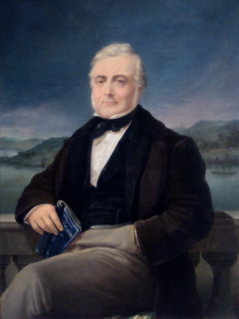 W
WThe September Revolution was a coup d'etat that took place on 9 September 1836 in Portugal and ended Devorismo, leading to the promulgation of the Constitution of 1838.
 W
WThe Serbian Revolution was a national uprising and constitutional change in Serbia that took place between 1804 and 1835, during which this territory evolved from an Ottoman province into a rebel territory, a constitutional monarchy, and modern Serbia. The first part of the period, from 1804 to 1817, was marked by a violent struggle for independence from the Ottoman Empire with two armed uprisings taking place, ending with a ceasefire. The later period (1817–1835) witnessed a peaceful consolidation of political power of the increasingly autonomous Serbia, culminating in the recognition of the right to hereditary rule by Serbian princes in 1830 and 1833 and the territorial expansion of the young monarchy. The adoption of the first written Constitution in 1835 abolished feudalism and serfdom, and made the country suzerain. The term Serbian Revolution was coined by a German academic historiographer, Leopold von Ranke, in his book Die Serbische Revolution, published in 1829. These events marked the foundation of modern Serbia.
 W
WThe Trienio Liberal is a period of three years in the modern history of Spain between 1820 and 1823, when a liberal government ruled Spain after a military uprising in January 1820 by the lieutenant-colonel Rafael de Riego against the absolutist rule of Ferdinand VII.
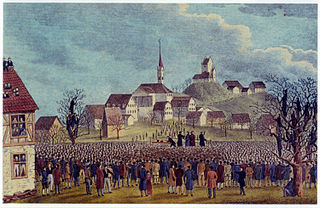 W
WThe Ustertag occurred on 22 November 1830, when 10,000 men of the Canton of Zürich gathered on Zimiker hill and demanded a new constitution. Their primary concern was parity between the urban and rural areas. The Ustertag is described as a "revolution" due to its impact, its focus, and its speed of events, which caused great change in the Canton of Zurich.